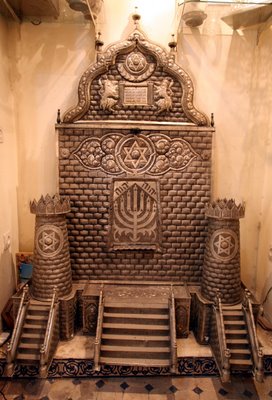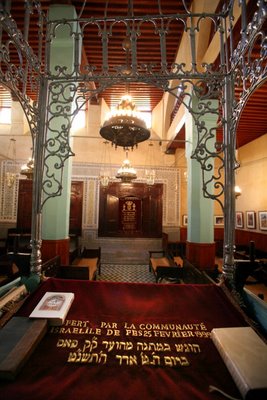
This week the Jewish Moroccan community hailed Morocco as being a land of religious coexistence.
"Our country will always remain an example of coexistence between Christianity, Judaism and Islam, and a land of tolerance where the faithful can freely and respectfully worship," said David Tolédano, Secretary general of the Israelite community in Rabat.
Speaking on the occasion of Yom Kippur, Toledano praised the kingdom's efforts to achieve development in various fields. Yom Kippur also known as "the Day of Atonement" is a Jewish holiday marked by fasting and prayer for the atonement of sins.
Morocco is presently home to around 6000 Jews living in the four corners of the North African country.

A short history of Jews in Morocco

Legend has it that Moroccan Jews have been here since the days of King David. In the south of Morocco, three days journey from Sousse - there is a boulder on which is engraved -“Joab, son of Zeriah, drove the Philistines to this point.” Joab ben Zeriah was one of King David’s captains. And so it has been concluded that Moroccan Jews have been in this North African country since the day of King David.
Jews seldom led a serene existence in Morocco for they were subject to the whims of their Moslem rulers. In 809, the Caliphate issued a number of decrees against the Jews; they wore only black garments, they were forbidden to ride horses, and only sandals were allowed them - no shoes. In addition they had to pay exorbitant taxes and were forced to live separately from the Arab population in Mellahs [Jewish quarter].
The Jews of Morocco fell into three categories. The mountain cave desert dwellers, those who lived in the Mellahs, and the so-called Spanish Jews.
The mountain Jews were extremely pious living in the spirit of Bibilical Palestine. Some would roam about the country, like pilgrims - looking for a “shochet,” or a “mohel,” others traveled about to bless every Jew they came across. Some knew a little Hebrew although Berber was their language.
Many wore gold earrings as a sign to the world that when the Hebrews in the wilderness forced Aaron to set up a golden calf and gave him ornaments to melt down - the ancestors of the present mountain Jews refused to do homage to the idol.
Eighty percent of the Jews of the country lived in a Mellahs of the cities and the towns. Mellah is the Arabic word for salt and folklore has it that the Jews were granted the protection of the Sultans in exchange for preserving the heads of their enemies is salt. All of the larger cities of Morocco had Mellahs - relics of older times. These were crowded - narrow winding streets - where the trading could be heard in high pitched tones, where there was a constant movement of figures in black and white turbans and tiny round skullcaps. Business was conducted on the sidewalk, with the Jewish artisans sitting in archways from early morning till late at night, sewing, stitching, patching shoes, and hammering gold and silver. Carving designs on bridal bracelets.

Modern Times
Prior to WWII, the Jewish population of Morocco reached 225,000. Although, Jews were not deported during WWII, they did suffer humiliation under the Vichy government. Following the U.S. landing in 1943, a few pogroms did occur. In June 1948, bloody riots in Oujda and Djerada killed 44 Jews and wounded scores more. That same year, an unofficial economic boycott was instigated against Moroccan Jews.
In 1956, Morocco declared its independence, and Jewish immigration to Israel was suspended. In 1963, emigration resumed, allowing more than 100,000 Moroccan Jews to reach Israel.
In 1965, Moroccan writer Said Ghallab described the attitude of his fellow Muslims toward their Jewish neighbors:
The worst insult that a Moroccan could possibly offer was to treat someone as a Jew....My childhood friends have remained anti-Jewish. They hide their virulent anti-Semitism by contending that the State of Israel was the creature of Western imperialism....A whole Hitlerite myth is being cultivated among the populace. The massacres of the Jews by Hitler are exalted ecstatically. It is even credited that Hitler is not dead, but alive and well, and his arrival is awaited to deliver the Arabs from Israel.
Fortunately this attitude no longer prevails. Before his death in 1999, King Hassan tried to protect the Jewish population, and at present Morocco has one of the most tolerant environments for Jews in the Arab world. Moroccan Jewish emigres, even those with Israeli citizenship, freely visit friends and relatives in Morocco. Moroccan Jews have held leading positions in the business community and government. The major Jewish organization representing the community is the Conseil des Communautes Israelites in Casablanca. Its functions include external relations, general communal affairs, communal heritage, finance, maintenance of holy places, youth activities, and cultural and religious life.
The Jews no longer reside in the traditional Jewish mellahs, but intermarriage is almost unknown. The community has always been religious and tolerant....The younger generation prefers to continue its higher education abroad and tends not to return to Morocco. Thus the community is in a process of aging.
In early 2004, Marrakech had a small population of about 260 people, most over the age of 60. Casablanca has the largest community, about 3,000 people. There are synagogues, mikvaot, old-age homes, and kosher restaurants in Casablanca, Fez, Marrakesh, Mogador, Rabat, Tetuan and Tangier. By 1992, most Jewish schools had closed, but Casablanca has experienced a bit of a renewal and now 10 schools serve more than 800 students there.
The Jewish community has developed a fascinating tradition of rituals and pilgrimages to the tombs of holy sages. There are 13 such famous sites, centuries old, well kept by Muslims. Every year on special dates, crowds of Moroccan Jews from around the world, including Israel, throng to these graves. A unique Moroccan festival, the Mimunah, is celebrated in Morocco and in Israel.
Morocco is perhaps Israel's closest friend in the Arab world. King Hassan often tried to be a behind-the-scenes catalyst in the Arab-Israeli peace process. In July 1986, he hosted Israeli Prime Minister Shimon Peres in an effort to stimulate progress. Two months later, Hassan met with a delegation of Jews of Moroccan origin, including an Israeli Knesset member. In 1993, after signing the agreement with the PLO, Prime Minister Yitzhak Rabin paid a formal visit to Morocco.
In May 1999, King Hassan organized the first meeting of the World Union of Moroccan Jews, in Marrakech.
In April and May 2000, the Moroccan government sponsored a series of events and lectures promoting respect among religions.7 Andre Azoulay, royal counselor and a leading Jewish citizen, spoke about the need for interfaith respect and dialogue. In October 2000, two Moroccan youths tried to vandalize a Tangiers synagogue. King Mohamed VI publicly declared in a televised speech on November 6, 2000, that the government would not tolerate mistreatment of Morocco’s Jews. The youths were subsequently sentenced to one year in prison.
On May 16, 2003, a series of suicide bombers attacked four Jewish targets in Casablanca, and a fifth attack was made against the Spanish consulate. No Jews were hurt in the attack because it occurred on Shabbat when the buildings were empty of Jews. Twenty-nine Muslims were killed. Though the bombings affected the Jewish sense of security, they were viewed by most Moroccans as assaults on the country's social and political order, and a test of the young king's power, rather than an act of anti-Semitism. King Mohammed VI visited the site of one of the attacks the day it occurred and urged the Jewish community to rebuild. The government subsequently organized a large rally in the streets of Casablanca to demonstrate support for the Jewish community and the king reasserted his family's traditional protection for the country's Jews.
Editor's note: This article draws on material from several sources including, local accounts, Wikipedia and the Jewish Virtual Library
Tags: Morocco Fes, Maghreb news

No comments:
Post a Comment